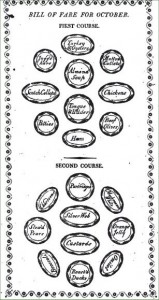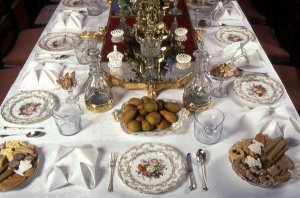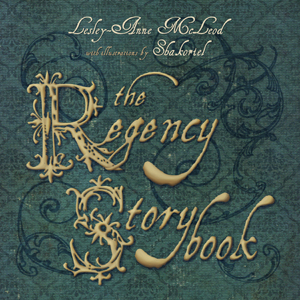She’s not only a friend and a wonderful writer but a mentor as well. I’m very excited to have Lesley-Anne McLeod here today to give us a peek into a Regency dining room!
As a writer of historical romance (in my case, Regency romances) I am always learning about my favourite history era, which is that of the Regency period in England from about 1800-1830. For research, I frequently use Google Books to find actual books and magazines from the period. Cookery books are among the most interesting to read, for styles in food and food service have certainly changed in two hundred years.
One book I have particularly enjoyed is The London Art of Cookery by John Farley Formerly Principal Cook at the London Tavern. It was published in 1811.
I found it of particular interest that there is a bill of fare laid out for each month of the year, showing which game, meat, fruit and vegetables are seasonal. Also there is an illustration of each table-top with the dishes marked for a first and a second course and showing the service. Here is the Bill of Fare for October:
 Many of the dishes require no explanation: custards, ham, broccoli, turkey and even oysters are not far from our everyday cooking. But some items are unusual to say the least.
Many of the dishes require no explanation: custards, ham, broccoli, turkey and even oysters are not far from our everyday cooking. But some items are unusual to say the least.
Scotch Collops are a cut of veal “the size and thickness of a crown piece”, done up in a mushroom, anchovy and lemon sauce. Beef Olives are rolled rump-steaks cooked with fat bacon and served with a gravy containing port wine, cayenne and ketchup.
Tongue and Udder caused me to shudder; they were parboiled and then roasted with cloves. Almond Soup contained veal and mutton as well as almonds and cream.
What, I wondered, were the Chardoons noted on the top left corner of the second course? Well, I went to the Index of the book and discovered they are the edible ‘flower’ of a large thistle-type plant, prepared as follows:
“Cut them about six inches long, string them, and stew them till tender. Then take them out, flour them, and fry them in butter till they are brown, Serve, with melted butter. Or you may tie them up in bundles, and boil them like asparagus. Put a toast under them, and pour a little melted butter over them.”
The biggest mystery in this Bill of Fare was one of the two central dishes of the second course–Silver Web. I thought it must either be a fish or a sweet and I went to the Index with anticipation. But there was no entry for Silver Web. I went to the Internet and did a search–nothing came up for Silver Web. Feeling frustrated, I recalled a great blog I often read–The Old Foodie http://www.theoldfoodie.com I emailed Janet and asked for her help. She was most generous with her information, and here it is:
“‘Silver Web’ was a spun sugar decoration for sweet dishes and puddings. It was considered very elegant indeed.
There are recipes from the mid-eighteenth century, but here is one from 1846 – the method did not change, and this cookery book is available on Google Books, in case you want to look it up. The Gold Web sounds gorgeous too.
From: The Complete Cook, J.M. Sanderson, 1846
To make a Silver Web.
Boil clarified syrup to the crack, using the same precautions as before observed, giving it a few boils after the acid is added; dip the bottom of the pan in water and let the sugar cool a little; then take the handle of a spoon, or two forks tied together, dip it into the sugar, and form it either on the inside or outside of a mould, with very fine strings, by passing the hand quickly backwards and forwards taking care that it does not fall in drops, which would spoil the appearance of the work. With this may be represented the hair of a helmet, the water of a fountain, &c. Take a fork or an iron skewer, and hold it in your left hand as high as you can dip the spoon in the sugar, and with the right hand throw it over the skewer, when it will hang from it in very fine threads of considerable length.
To make a Gold Web.
Boil syrup to caramel height, colouring it with saffron, and form it as directed for the last. It can be folded up to form bands or rings &c. Fasten it to the other decorations with caramel. If any of the strings or threads of sugar should pass over those parts where they are not required so as to spoil the other decorations in the making of baskets or other ornaments, it may be removed with a hot knife without breaking or injuring the piece.”
The Regency table (of the upper classes) really was a thing of beauty when laid for a dinner party. Here is a recreation by food historian Ivan Day. You can view his work at Historic Food, http://www.historicfood.com/portal.htm
 My next book will host a very fine Regency feast–though it might not include Tongue and Udder! My newest release The Regency Storybook contains twelve stories and twelve illustrations by my favourite artist, Shakoriel, but very little mention of food, other than tea and biscuits.
My next book will host a very fine Regency feast–though it might not include Tongue and Udder! My newest release The Regency Storybook contains twelve stories and twelve illustrations by my favourite artist, Shakoriel, but very little mention of food, other than tea and biscuits.
 Merry Christmas to you all, and do enjoy your Christmas dining.
Merry Christmas to you all, and do enjoy your Christmas dining.
Lesley-Anne McLeod
 Lesley-Anne McLeod has been writing for thirty years, around motherhood and a ten year career in bookselling. A life-long Anglophile, it seemed natural that she should write Regency romances, those uniquely English historical romances. She takes her inspiration from the work of Jane Austen and Georgette Heyer. Lesley-Anne has had nine full-length Regency romance ebooks published and numerous short stories and novellas. The Regency Storybook is available in print and you can view it here: http://www.lesleyannemcleod.com/regencystorybook.html
Lesley-Anne McLeod has been writing for thirty years, around motherhood and a ten year career in bookselling. A life-long Anglophile, it seemed natural that she should write Regency romances, those uniquely English historical romances. She takes her inspiration from the work of Jane Austen and Georgette Heyer. Lesley-Anne has had nine full-length Regency romance ebooks published and numerous short stories and novellas. The Regency Storybook is available in print and you can view it here: http://www.lesleyannemcleod.com/regencystorybook.html
http://www.lesleyannemcleod.com
http://www.lesleyannemcleod.blogspot.ca/
http://lesleyannemcleod.tumblr.com/
https://www.facebook.com/lesleyanne.mcleod
https://twitter.com/lesleyannemc
https://www.uncialpress.com/Lesley-Anne-McLeod/
